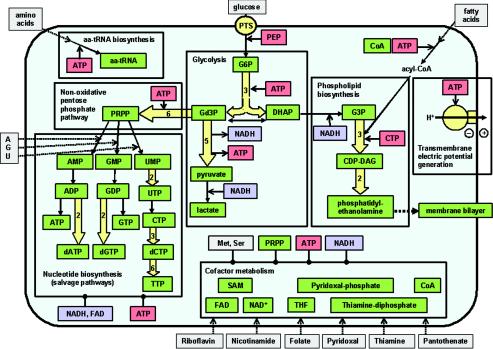FIG. 1.
A minimal metabolism. The minimal cell can obtain its more basic components from the environment: glucose, fatty acids, amino acids, adenine, guanine, uracil, and coenzyme precursors (nicotinamide, riboflavin, folate, pantothenate, and pyridoxal). Each box includes the metabolic transformations classified in major groups of pathways: glycolysis, phospholipid biosynthesis, nonoxidative pentose-phosphate pathway, nucleotide biosynthesis, synthesis of enzymatic cofactors, and synthesis of protein precursors, i.e., aminoacyl-tRNAs (aa-tRNA). Arrows with discontinuous lines represent incorporation from the environment. Single continuous arrows represent single enzymatic steps, whereas wide arrows represent several enzymatic steps (the number within the arrow indicates the number of steps). Lines with a final black point indicate the necessity of metabolites for some of the transformations inside the corresponding box. Metabolic intermediates and final pathway products are in green boxes. Metabolites acting as a source of chemical energy are in red boxes. Reducing-power cofactors are in light blue boxes. Abbreviations (besides the accepted symbols and those defined in the text): PEP, phosphoenolpyruvate; G6P, glucose-6-phosphate; Gd3P, glyceraldehyde-3-phosphate; DHAP, dihydroxyacetonephosphate; G3P, sn-glycerol-3-phosphate; CDP-DAG, CDP-diacylglycerol; SAM, S-adenosylmethionine; THF, tetrahydrofolate. Metabolic precursors of external origin are in gray boxes.

